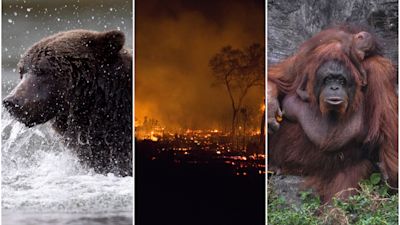Climate and land use changes have caused almost fifth of habitat loss worldwide

Climate change and changes of land use have caused mammals, birds and amphibians to lose on average 18% of their habitat worldwide since 1700, research indicates.
This could rise to a 23% loss in the next 80 years in a worst-case scenario, according to the Cambridge University study.
The size of an animal's habitat, by geographical range, is a strong predictor of a species' vulnerability to extinction.
The study, published in the journal Nature Communications, analysed changes in the geographical range of 16,919 species from 1700 to the present day.
Data was also used to predict future changes up to the year 2100 under 16 different climate and socio-economic scenarios.
The study's first author Dr Robert Beyer, of Cambridge's Department of Zoology, said:
The amount of habitat loss varies, with 16% of species having already lost more than half of their estimated natural range. This figure could rise to 26% of species by the end of the century, according to the research.
Species' geographical ranges were found to have recently shrunk most significantly in tropical areas, where for instance rainforest has been cleared for oil palm plantations in South East Asia and for pasture land in South America. Many species there live in smaller geographical areas to begin with.
"The tropics are biodiversity hotspots with lots of small-range species," said Dr Beyer. "If one hectare of tropical forest is converted to agricultural land, a lot more species lose larger proportions of their home than in places like Europe."
The research suggests that climate change will have an increasing impact on species' geographical ranges. Rising temperatures and changing rainfall patterns will alter habitats significantly, for example.
Norfolk Wildlife Trust looking to extend and preserve unique ice age habitat
University to cut ties with fossil fuels following campaigns in "landmark" decision
Other studies have predicted that without climate action, large parts of the Amazon may change from canopy rainforest to a savannah-like mix of woodland and open grassland in the next 100 years.
"Species in the Amazon have adapted to living in a tropical rainforest," said Dr Beyer. "If climate change causes this ecosystem to change, many of those species won't be able to survive - or they will at least be pushed into smaller areas of remaining rainforest.
He added:
Reducing the amount of agricultural land around the world by introducing new policy measures could help, the research suggests. These could include encouraging people to eat less meat, and stabilising population growth.
Professor Andrea Manica, of Cambridge's Department of Zoology, said: "Whether these past trends in habitat range losses will reverse, continue, or accelerate will depend on future global carbon emissions and societal choices in the coming years and decades.
A New Hope: Celebrations for success of eco-friendly farming experiment
Thinking outside the box: Ipswich firm launches recycled paper wine bottle